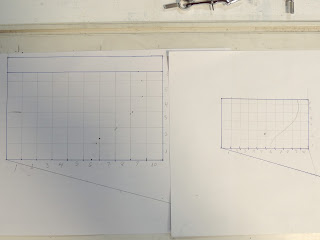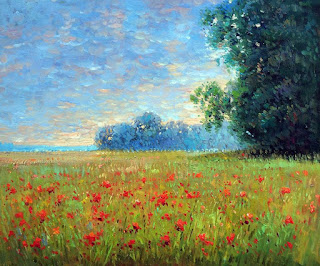Not everyone has easy access to enlarging copiers. Even when they are available, large enlargement
ratios produce distortions. This
presents a dilemma when a big enlargement is needed. Is it necessary to redraw the whole design at
a larger scale? There is a way to
enlarge a design without machines or needing to redraw the whole. This is a description of how it can be done.
The old fashioned way to enlarge
an image is to grid the smaller original. This grid is normally made in squares of
convenient size. The grid size does not
have to fit evenly into the dimensions of the original. It is easier if the longest side has a size
of grid that fits evenly into it. This
probably means there will be an uneven fit of the square grid on the other
dimension. This is not a big problem.
The size of the grid is related
to the amount of detail. More detailed original
images need smaller squares than images with less detail. Detailed images may require a 1cm/0.375”
square grid or less. This is to ensure
all the detail is included in the enlarged image. A less detailed original may only need a
2.5cm/1.0” grid.
Also, bigger enlargements
require more squares on the original than smaller enlargements. If you are enlarging more than three times,
you should be looking toward smaller squares for the grid. This allows you to maintain the curves and
angles more easily on the enlarged copy. Smaller enlargements
can have a larger grid size. The
relevance of the grid size becomes apparent when you set out the enlarged grid.
It is useful to use a set of
dividers to ensure the repeated grid size is set out on the boundaries of the
original image size. Once set, the
distance between the two points of the dividers remains constant as you “walk”
them along the boundaries. If you mark
all four sides of the image with the dividers, you only need a straight edge to
draw the grid lines. I draw the lines in
pencil. Then if I make any mistakes, I can erase the lines and set new ones.
On another piece of paper set
out the new enlarged size boundaries. If
you have set the boundaries at the correct size relative to the original, the
new grid should fit evenly into the long dimension. Multiply the grid size on the original by the
enlargement ratio. This gives you the size
of the enlargement grid. Set your
dividers to this and mark off the enlarged grid.
In fact, most of the time, the
difference between the final enlarged and the original size determines the enlargement
ratio. To get this ratio, divide the
enlarged size by the original size to get the ratio. This ratio needs to be applied to the new
grid size. If it does not fit well,
adjust the dividers to the required size and mark the length again.
Example:
·
The approved
design is 10 by 15cm/ 4” by 6”
·
The final
size is to be 60 by 91.5cm/ 24” by 36” (assuming your design is in the same
proportions as the final size).
·
Assuming
your design is of moderate detail, squares of 1cm/ 0.39” might be enough to
capture the detail. For more detail,
smaller squares would be required.
·
To
determine the size of the squares in the full size design, divide the final
size by the design size. I prefer to use
the bottom side for this calculation, but either side will work. The bottom
side of the full size is 60cm, and the design is 10cm. The division shows that
the squares on the full size need to be in a ratio of 1:6.0. This means the squares
on the full size need to be 6.0cm/ 2.4”.
·
If this
appears to be too large a grid, the squares can be divided to capture more
detail.
The next blog post will show
how to divide the design and full size without using maths at all.
Having marked the edges of the
design with the grid sizes, draw the grid across the design. Do this in pencil, so the grid lines can be
erased when the enlargement is completed. This will give intersections between
the design lines and both the grids.
Enlarging involves marking these
intersections on the full size grid in proportional locations. E.g., if on the design the intersection on
the grid line is 2/3 up the grid square. On the large one mark it also 2/3 up on the
corresponding square. Do one line at a time to avoid confusion. When as much of the line intersections as you
want for that element are transferred, draw the line in on the full size. There will need to be some adjustment when
finished, so use a pencil for all these operations.
When satisfied with the look of
the full size, ink in the lines and erase the grid and any unwanted lines. You
now have a full size cartoon to work with.
Manually enlarging a design is
most useful when you do not have access to machines, and when the enlargement
is more than two times. Machines distort
the lines at high magnifications and require checking and often redrawing of edges
and various elements anyway.






































